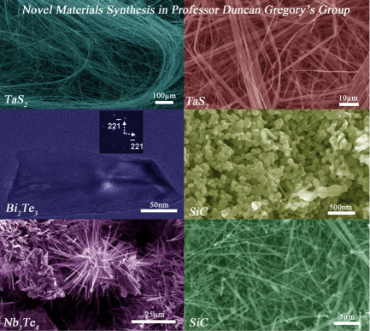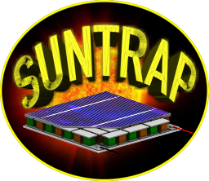Component fabrication and processing
Using triple junction (InGaP, InGaAs, Ge) wafers from IQE we will use the JWNC to produce a number of PV concentrator cells with spider top contact, anti-reflective coating and back reflector / Ohmic contact.
The development of new phase change and thermoelectric materials. A key component of the SUNTRAP systems-level approach is the use of hot and cold thermal stores. As energy is absorbed or released, a straightforward fluid-based store would provide an approximately linear change in temperature with stored energy. Using phase-change materials suspended within the working fluid, each changing phase at a different temperature, a quantised energy / temperature profile can be produced, forming discrete temperature zones within which the system can operate, and increasing the overall heat capacity. Importantly, the phase-change will occur within the CPV-TE module and therefore contribute to the linearization of working temperature across the area of the cell – critical to efficient operation of the CPV layer.
Work in WP2 will also investigate the suitability of thermoelectric materials for use at different temperatures in solar thermal applications. For < 250°C, bismuth telluride will be used with the CPV components. Above this temperature, a variety of novel materials options will be explored.
Overview of Inorganic Solid State and Materials Chemistry
Professor Duncan Gregory’s Inorganic Solid State and Materials Chemistry research group has strong interests and expertise in synthesis, structural characterisation and physical property evaluations of inorganic solids. The underlying theme in our approach is to design, identify and modify materials on the basis of their atomic or ionic arrangements. To achieve this in exotic systems of materials requires use of innovative and unusual synthetic approaches. Methods including microwave-assisted synthesis, chemical vapour transport, solid state and solution-phase synthesis have been developed towards sustainable materials synthesis.
Low dimensional, metal chalcogenide nanomaterials, such as Bi2Te3 nanosheets and TaS2 nanowires, have been produced in our lab and hold promise for thermoelectric conversion. Through advanced structural characterisation and performance evaluation, the fundamental relationships between synthesis, structure and physical properties have been extensively explored and established. The group's current research breaks down into several key areas: non-oxide materials, fuel storage, sustainable energy materials, inorganic nanomaterials and sustainable materials processing.
Working as part of the SUNTRAP project, our group will focus on development of new thermoelectric materials and phase-change materials (PCMs), which are two important components in the proposed energy conversion system. Lead-free, low toxicity metal selenides, which consist of earth-abundant elements will be investigated. A comprehensive study on the synthesis of metal selenide single crystals, polycrystalline materials and nanostructures, will be performed, together with evaluation of thermoelectric performance. We expect in this study to not only develop new materials having better thermoelectric performance than currently available materials, but also to initiate new synthetic strategies for synthesizing materials with enhanced thermoelectric conversion efficiency.
We are also currently working on encapsulated PCMs where a PCM core is encapsulated in a non-active shell to form micro- or nano-composite materials. Such composite PCMs will have many evident advantages in terms of structural, mechanical and thermal stability. Through developing and incorporating new thermoelectric materials and PCMs in the harvesting system, we expect to enhance the energy conversion efficiency of the system.

References
- Kitchen, H. J.; Vallance, S. K.; Kennedy, J. L.; Tapia-Ruiz, N.; Carassiti, L.; Harrison, A.; Whittaker, A. G.; Drysdale, T. D.; Kingman, S. W.; Gregory, D. H., Modern Microwave Methods in Solid-State Inorganic Materials Chemistry: From Fundamentals to Manufacturing. Chem. Rev. 2014, 114, 1170-1206.
- Zhao, Y. M.; Hughes, R. W.; Su, Z. X.; Zhou, W. Z.; Gregory, D. H., One-Step Synthesis of Bismuth Telluride Nanosheets of a Few Quintuple Layers in Thickness. Angew. Chem. Int. Ed. 2011, 50, 10397-10401.
- Cameron, J. M.; Hughes, R. W.; Zhao, Y. M.; Gregory, D. H., Ternary and higher pnictides; prospects for new materials and applications. Chem. Soc. Rev. 2011, 40, 4099-4118.
- Carassiti, L.; Jones, A.; Harrison, P.; Dobson, P. S.; Kingman, S.; MacLaren, I.; Gregory, D. H., Ultra-rapid, sustainable and selective synthesis of silicon carbide powders and nanomaterials via microwave heating. Energy Environ. Sci. 2011, 4, 1503-1510.
- Dunnill, C. W.; MacLaren, I.; Gregory, D. H., Superconducting tantalum disulfide nanotapes; growth, structure and stoichiometry. Nanoscale 2010, 2, 90-97.
- Shi, W. D.; Hughes, R. W.; Denholme, S. J.; Gregory, D. H., Synthesis design strategies to anisotropic chalcogenide nanostructures. CrystEngComm 2010, 12, 641-659.
- Vallance, S. R.; Round, D. M.; Ritter, C.; Cussen, E. J.; Kingman, S.; Gregory, D. H., Ultrarapid Microwave Synthesis of Superconducting Refractory Carbides. Adv. Mater. 2009, 21, 4502-4504.
- Dunnill, C. W.; Edwards, H. K.; Brown, P. D.; Gregory, D. H., Single-step synthesis and surface-assisted growth of superconducting TaS2 nanowires. Angew. Chem. Int. Ed. 2006, 45, 7060-7063.


